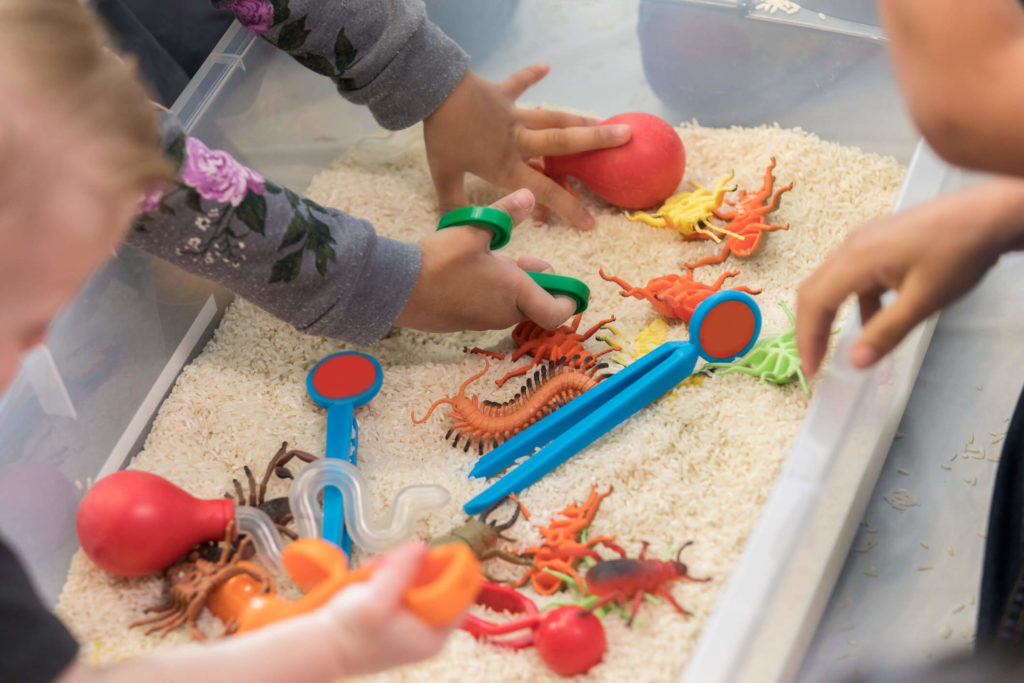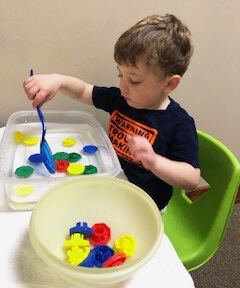Exploring the World Through Sensory Play

From infancy through childhood, children learn about their world using their senses or sensory play. They do this by touching, tasting, smelling, seeing, moving, and hearing. Even as adults we tend to learn best and retain information when we engage our senses. How many of us have walked into a room to be filled with memory only because of the smell? Or how a song can send a flood of memories of good times with friends. It is the sensory experience that has helped keep those memories as if they happened yesterday.
Providing sensory play activities for your children is one of the simplest, and most fun, way to explore and learn about the world! There are many different types of sensory play activities, including those that use the sense of smell, hearing, sight, and movement. The sense of touch is another way children gain information and develop an understanding of the big world that awaits! These experiences play an important role in development.
So, exactly what is, and how do you provide sensory play activities for your child? Simply put, sensory play is any type of play that activates and stimulates a child’s senses. Sensory play is tons of fun and simple to set up, but it can be difficult for parents to think of ideas to help their child engage in sensory activities. Here is some advice…keep it simple! Hopefully, the following ideas will get you, and your child, onto fun ways to explore and learn together.
Create Sensory Play Bins
It is simple for children to enjoy sensory play when you create a sensory bin for them to explore. These are easy to make by filling bins with various items. There are endless things to use. Rocks, sand, leaves, cotton balls, beans, rice, and pasta are a few that are easily found around your home. Hide small toys/objects to find or use scoops and spoons to fill containers.
Sensory Play With Food
Your first response is probably, “You are crazy!” Yes, it gets messy, but allowing your little one to play with food — squishing, smearing, and tasting as they go — gives them a sensory experience that helps them learn. It may increase your child’s interest in trying new foods, especially fruits and vegetables. Use pudding, whipping cream, or yogurt to make roads for cars or to imitate lines and circles.
Play Dough
Play dough recipes are so easy to find and can be made from items commonly found in your home. Or purchase Play-Doh on a quick trip to your local Target or Walmart! Many of the play dough recipes are edible which is a bonus when using with young children that like to put things in their mouths! Adding simple tools such as cookie cutters, rolling pins, and for preschool aged children, plastic knifes and scissors provide more learning experiences.
Sound Tubes
Start saving those paper towel and toilet paper rolls! Next collect a variety of different things to put inside, such as beads, rice, or beans. Fill the tubes and safely seal them, duct tape works great. And as easy as that you have created a sound tube for your little one that helps them connect with the auditory world around them as they enjoy the different sounds each one makes.
Swinging, Spinning, and Rolling
Swings are often a favorite activity for children. Challenge them by having the swing on their bellies to fly like “Superman”. Instead of pushing them from behind give pushes through the bottoms of the feet, or pull their feet then gently release. A totally different sensation can be given by gently twisting the swing. Spinning in circles, rolling down a hill, or rolling across the floor are other simple ways that a child can experience movement in natural and playful ways.
Pillow Crash
What home does not have pillows! Pull cushions off the couch or grab the bed pillows and let the fun begin. Jumping into pillows, rolling across pillows, or hiding under them while others give gentle pushes is a great way to provide deep pressure or proprioceptive input. This type of sensory play helps your child understand where their bodies are in space and helps in developing body awareness.
 Water Sensory Play
Water Sensory Play
Water play may be the simplest way to give your child sensory play experiences. Whether it is in the bath tub, the kitchen sink, the outdoor pool, at the lake or nearby stream water provides endless fun for all ages. Adding simple common items such as cups, balls, sponges, squirt guns only add to the fun. Water play can be as simple as putting fingertips in, or jumping with both feet, or totally immersing themselves – each one giving a unique sensory experience.
These are only a few ways to provide your child with sensory play activities. They do not need to be complicated to be fun and most items can be found in your home. While it can get messy from time to time, helping your child engage with their senses will give them the chance to learn and grow as they interact with the world around them!
For more ideas, check out Little Bins for Little Hands to get over 50 sensory play activities. If you have concerns that your child doesn’t want to engage in sensory play, check out this blog on Sensory Processing Disorder to learn more and to learn how occupational therapy can help.
